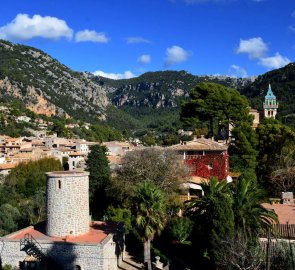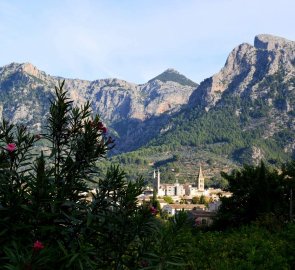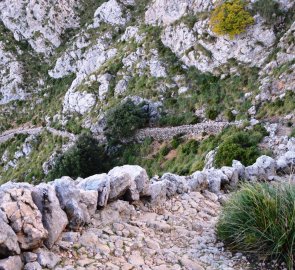7-day crossing of Mallorca on the GR221 route
Mountain range, region / State
Serra de Tramuntana / Spain
Season
Fall
04. 11. - 11. 11. 2023
Difficulty
3 / 5
Elevation
↑ 6441 m
↓ 6393 m
Length
118.3 km
8 days
Altitude
max. 1210 m n.m.
min. 1 m n.m.
GR221 - Crossing of Mallorca
Starting point
The trek starts in the town of Andratx, in the western part of the island.
Description of the hike
1. day
We started our route in Port d'Andratx, where there is a direct bus from Pollency. We ascended to the pass of Vermell (286 m), where we eventually bivouacked in the beautiful sunset with a flock of brown vultures overhead. Bivouacing is not exactly allowed in Mallorca, but let's just say it is tolerated, there are patches made all along the route by people who have stayed overnight. It's just a good idea to stagger your route so that the night doesn't come out on the mountain tops, it's hard to find the equator and leeward areas there. Mountain huts for overnighting are also along the way. There is a charge for the night, but you will have the luxury of a bed and a hot meal.
2. day
The next day we walked through the coastal village of Sant Elm and continued on. GR221 is marked on the maps, but we saw the ofocial signposts only from the ruins of the antic monestir de La Trapa until then we walked more on the built stone men. The route was well marked then. We spent the night in the parking lot of the coll de sa Gramola.
3. day
On the third day, we had a beautiful valley with donkeys, goats and sheep. We then climbed the Pas d'en Ponsa (686m) and continued along the trail to the Font de s'Obi spring - one of the few places where you can get water other than by buying it. The bivouac hut was occupied so we continued on and slept a bit on the punk at the luxury villas above the village of Banyalbufar. There were cameras everywhere but darkness was falling fast so we crawled a little out of the way and tried to be invisible. If we'd known what was coming next we'd have walked a few more metres to the Coll des Pi saddle, there were more flats there.
4. day
The next day we walked through the village of Esporles, where you can buy food and drink. We got a little lost climbing the Mola de sa Comuna (714m), but found and retraced our steps through the beautiful village of Valdemossa to the bivouac hut Refugi de son Moragues, where we stayed for the night.
5. day
In the morning we had to climb Es Caragolí (945 m). It was a beautiful view, no people anywhere, perfect weather. Then we descended to Deiy and then to Soller, where there were a lot of people. We quickly made it through and headed up the climb to the coll de l'Ofre. We didn't make it, so we camped about halfway up the hill on the olive terraces overlooking the twinkling Soller.
6. day
On the sixth day we found an abandoned donkey, where we hid and waited for the rain to pass. The rest of the day was quite challenging. The wind was strong, it was muddy and we had to climb the highest point of our trip - Coll des Prat (1205 m) and then descend to the most beautiful village on the route - Lluz . It's hard to say whether it was the relief of having made it through the day or the local atmosphere, but this mountain pilgrimage village is my favourite memory of the whole route. We stayed overnight in the parking lot, we were allowed to do so by the owner of a local restaurant, but he warned us that a ranger was coming to check on us every morning at 7am, so we should get up early. It was no problem. Otherwise, I recommend the local restaurant! They have great Paella (classic Spanish risotto) and the service is very nice.
7. day
In the morning we visited the botanical garden in Lluc and admired the huge sundial on the hill Pujolet des Misteris. Our last day was the last one, when we reached Pollenca. Officially the route ends at Port de Pollenca, but the road is then along a busy road, so we took a bus ride.
Difficulty
An easier long-distance trek primarily on natural trails (roads all the way to the Port). Ideal for spring/autumn when Mallorca is less crowded and less hot. The elevation gain is not challenging, the terrain is also manageable, no climbing or ferrata. The highest point is Coll des Prat (1205 m). Even trained dogs could manage the route.
Water availability
Almost no water, you have to buy it, but you can get it every day in some mountain village.
Sleeping options
We slept under a tent, a sleeping bag. If it rained we had only a tent, we didn't carry a tent. There are also bivouac huts on the way.
Mountain peaks
There are no cable cars on the trail, you can hike everything, the views are worth it and are beautiful from every ridge you find yourself on. The highest point of the trek is Coll des Prat 1 205 m above sea level.
Danger
Probably the biggest danger is the lack of water during the summer, otherwise it is quite a safe trek.
Food
We had our own supplies, we couldn't get a gas bomb, even though there are two decathlons in Palma, they were sold out. But there are plenty of restaurants along the way where you can buy good food.




